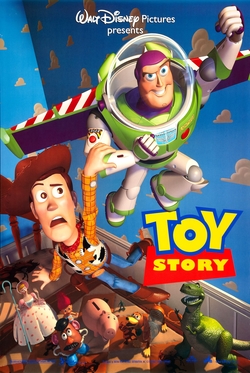
Toy Story is a 1995 American animated comedy film produced by Pixar Animation Studios for Walt Disney Pictures. The first installment in the franchise of the same name, it was the first entirely computer-animated feature film, as well as the first feature film from Pixar. It was directed by John Lasseter and produced by Bonnie Arnold and Ralph Guggenheim, from a screenplay written by Joss Whedon, Andrew Stanton, Joel Cohen, and Alec Sokolow and a story by Lasseter, Stanton, Pete Docter, and Joe Ranft. The film features music by Randy Newman, and was executive-produced by Steve Jobs and Edwin Catmull. The film features the voices of Tom Hanks, Tim Allen, Don Rickles, Jim Varney, Wallace Shawn, John Ratzenberger, Annie Potts, R. Lee Ermey, John Morris, Laurie Metcalf, and Erik von Detten.
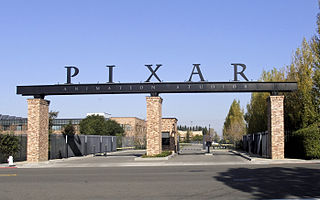
Pixar Animation Studios is an American animation studio based in Emeryville, California, known for its critically and commercially successful computer-animated feature films. Since 2006, Pixar has been a subsidiary of Walt Disney Studios, a division of Disney Entertainment, a segment of the Walt Disney Company.
Modern animation in the United States from the late 1980s to the early 2000s is frequently referred to as the renaissance age of American animation. During this period, many large American entertainment companies reformed and reinvigorated their animation departments, following the dark age, and the United States had an overall profound effect on animation globally.
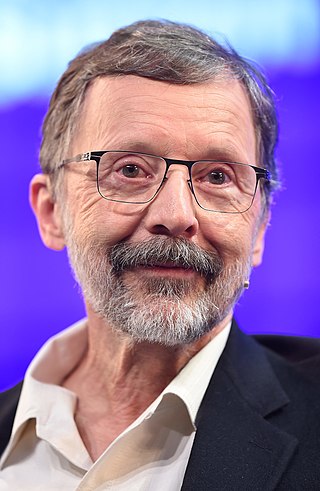
Edwin Earl Catmull is an American computer scientist and animator who served as the co-founder of Pixar and the President of Walt Disney Animation Studios. He has been honored for his contributions to 3D computer graphics, including the 2019 ACM Turing Award.
Autodesk 3ds Max, formerly 3D Studio and 3D Studio Max, is a professional 3D computer graphics program for making 3D animations, models, games and images. It is developed and produced by Autodesk Media and Entertainment. It has modeling capabilities and a flexible plugin architecture and must be used on the Microsoft Windows platform. It is frequently used by video game developers, many TV commercial studios, and architectural visualization studios. It is also used for movie effects and movie pre-visualization. 3ds Max features shaders, dynamic simulation, particle systems, radiosity, normal map creation and rendering, global illumination, a customizable user interface, and its own scripting language.

Toy Story 2 is a 1999 American animated adventure comedy film produced by Pixar Animation Studios for Walt Disney Pictures. The second installment in the Toy Story franchise and the sequel to Toy Story (1995), it was directed by John Lasseter, co-directed by Ash Brannon and Lee Unkrich, and produced by Helene Plotkin and Karen Robert Jackson, from a screenplay written by Andrew Stanton, Rita Hsiao, Doug Chamberlin, and Chris Webb, and a story conceived by Lasseter, Stanton, Brannon, and Pete Docter. In the film, Woody is stolen by a toy collector, prompting Buzz Lightyear and his friends to rescue him, but Woody is then tempted by the idea of immortality in a museum. Tom Hanks, Tim Allen, Don Rickles, Jim Varney, Wallace Shawn, John Ratzenberger, Annie Potts, R. Lee Ermey, John Morris, and Laurie Metcalf reprise their roles from the first film and they are joined by Joan Cusack, Kelsey Grammer, Estelle Harris, Wayne Knight, and Jodi Benson, who play the new characters introduced in this film.
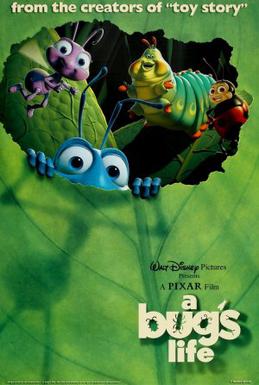
A Bug's Life is a 1998 American animated comedy film produced by Pixar Animation Studios for Walt Disney Pictures. It is Pixar's second feature-length film, following Toy Story (1995). The film was directed by John Lasseter, co-directed by Andrew Stanton, and produced by Darla K. Anderson and Kevin Reher, from a screenplay written by Stanton, Donald McEnery, and Bob Shaw, and a story conceived by Lasseter, Stanton, and Joe Ranft. It stars the voices of Dave Foley, Kevin Spacey, Julia Louis-Dreyfus, and Hayden Panettiere. In the film, a misfit ant named Flik, looks for "tough warriors" to save his ant colony from a protection racket run by a gang of grasshoppers. However, the "warriors" he brings back were a troupe of Circus Bugs. The film's plot was initially inspired by Aesop's fable The Ant and the Grasshopper.

Tin Toy is a 1988 American animated short film produced by Pixar and directed by John Lasseter. The short film, which runs for five minutes, stars Tinny, a tin one-man band toy, trying to escape from Billy, a human baby. The third short film produced by the company's small animation division, it was a risky investment: due to the low revenue produced by Pixar's main product, the Pixar Image Computer, the company was under financial constraints.

Knick Knack is a 1989 American animated short film produced by Pixar that was written and directed by John Lasseter. The short is about a snow globe snowman who wants to join the other travel souvenirs in a summer-themed party. However, the glass dome that surrounds him prevents him from doing so, thus leading to his many tries to break out of his snow globe. Knick Knack is Pixar's fourth short and the final short produced during the company's tenure as a hardware company. It was also the final Pixar short film released before the company's first feature-length film Toy Story.
In the field of 3D computer graphics, a subdivision surface is a curved surface represented by the specification of a coarser polygon mesh and produced by a recursive algorithmic method. The curved surface, the underlying inner mesh, can be calculated from the coarse mesh, known as the control cage or outer mesh, as the functional limit of an iterative process of subdividing each polygonal face into smaller faces that better approximate the final underlying curved surface. Less commonly, a simple algorithm is used to add geometry to a mesh by subdividing the faces into smaller ones without changing the overall shape or volume.

Luxo Jr. is a 1986 American animated short film produced and released by Pixar. Written and directed by John Lasseter, the two-minute short film revolves around one larger and one smaller desk lamp. The larger lamp, named Luxo Sr., looks on while the smaller, "younger" Luxo Jr. plays exuberantly with a ball to the extent that it accidentally deflates. Luxo Jr. was Pixar's first animation after Ed Catmull and John Lasseter left the Lucasfilm Computer Division. The film is the source of Luxo Jr., the mascot of Pixar.
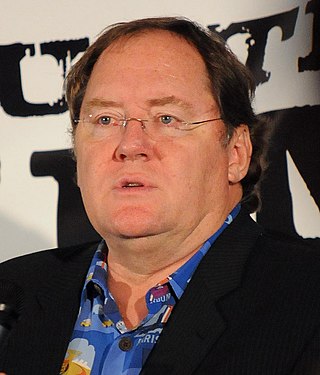
John Alan Lasseter is an American film director, producer, and animator. He has served as the Head of Animation at Skydance Animation since 2019. Previously, he acted as the chief creative officer of Pixar Animation Studios, Walt Disney Animation Studios, and Disneytoon Studios, as well as the Principal Creative Advisor for Walt Disney Imagineering.

Red's Dream is a 1987 American animated short film written and directed by John Lasseter and produced by Pixar. The short film, which runs four minutes, stars Red, a unicycle. Propped up in the corner of a bicycle store on a rainy night, Red dreams of a fantasy where it becomes the star of a circus. Red's Dream was Pixar's second computer-animated short following Luxo Jr. in 1986, also directed by Lasseter.

Jan Jaroslav Pinkava is a Czech-British-American producer, director, writer, and animator. He directed the Pixar short film Geri's Game and served as co-director and co-wrote the story for Ratatouille, both of which went on to win Oscars.

Joseph Henry Ranft was an American animator, screenwriter, and voice actor. He worked for Pixar Animation Studios and Disney at Walt Disney Animation Studios and Disney Television Animation. His younger brother Jerome Ranft is a sculptor who also worked on several Pixar films.
William Everett "Bud" Luckey was an American artist, cartoonist, illustrator, musician, singer and voice actor. He worked at the animation studio Pixar, where he worked as a character designer on a number of films, including Toy Story, Toy Story 2, A Bug's Life, Monsters, Inc., Finding Nemo, Cars and Ratatouille. Luckey was also the voice of Rick Dicker in The Incredibles, Chuckles the Clown in Toy Story 3 and as Eeyore in Winnie the Pooh (2011).

Circle Seven Animation was a short-lived division of Walt Disney Feature Animation specializing in computer-generated imagery (CGI) animation and was originally intended to create sequels to the Disney-owned Pixar properties, leading rivals and animators to derisively nickname the division "Pixaren't". The studio did not release any films during its existence, nor were any of its scripts used by Pixar.
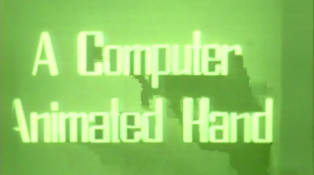
A Computer Animated Hand is the title of a 1972 American computer-animated short film produced by Edwin Catmull and Fred Parke. Produced during Catmull's tenure at the University of Utah, the short was created for a graduate course project. After creating a model of his left hand, 350 triangles and polygons were drawn in ink on its surface. The model was digitized from the data and laboriously animated in a three-dimensional animation program that Catmull wrote.

Angus MacLane is an American animator, filmmaker and voice actor, best known for his work at Pixar Animation Studios. He co-directed the film Finding Dory (2016) and made his solo feature directorial debut with the Toy Story spin-off film Lightyear (2022). MacLane is also a Lego enthusiast and created the CubeDudes building format and designed a LEGO WALL-E that has become an official set from The Lego Group.

Michael Kass is an American computer scientist best known for his work in computer graphics and computer vision. He has won an Academy Award and the SIGGRAPH Computer Graphics Achievement Award and is an ACM Fellow.
















